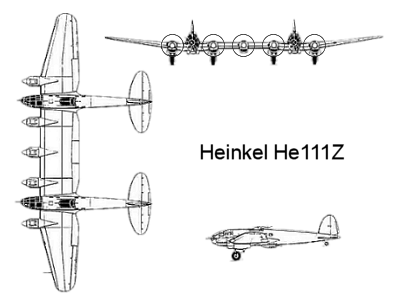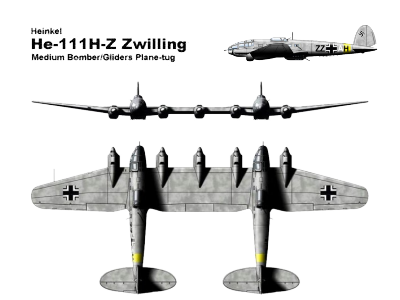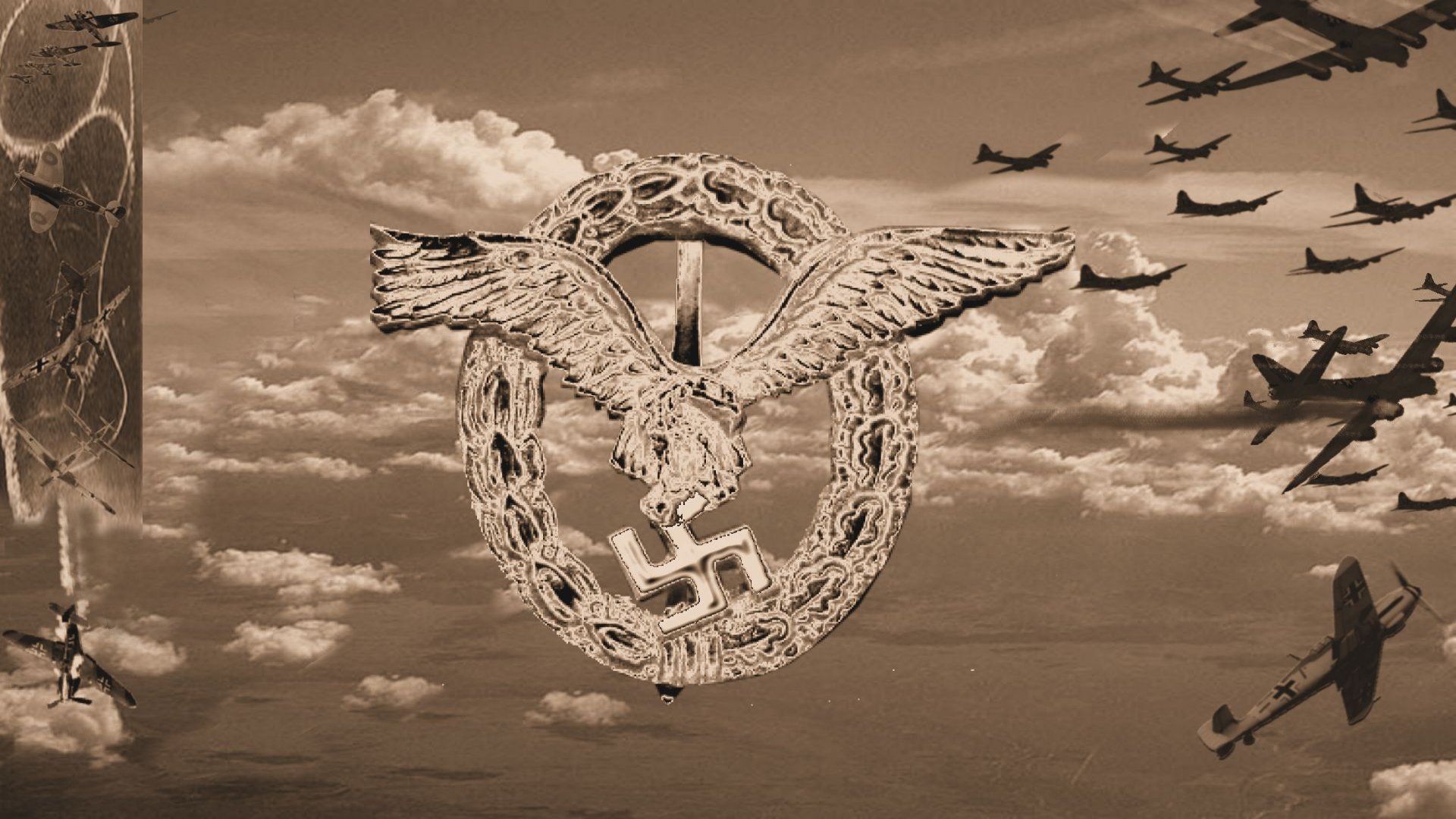When first unveiled in the early 1930s, the He 111 was presented as a fast transport, designed to carry mail over long distances quickly. Its true purpose was a fast medium bomber. The He 111 made its combat debut during the Spanish Civil War and went on to serve throughout the Second World War.
Development
The Heinkel He 111 arose from a 1934 design specification for a fast twin-engined passenger and bomber aircraft issued jointly by the embryonic Luftwaffe and the national airline, Lufthansa. The He 111's designers, twins Siegfried and Walter Günter, meant the airplane to carry a 1,000-kg (2,205-lb) bomb load, three 7.92-mm (0.312-in) machine guns (one in the glazed nose, one in a retractable ventral 'dustbin' turret, and a third in a dorsal position), and a crew of four. Two BMW V1 6.0 Z 12-cylinder water-cooled engines with a maximum output of 660 hp (492 kW) would supply the power. On 4 May 1936, construction began, and exactly one year later the first He 111 rolled off the production line. The newly impressed Luftwaffe accepted this aircraft and 'Kampfgeschwader' (bomber squadron; abbreviated KG) 154 put the He 111B-1 to work by winter 1936, a mere eight months after the fifth prototype had been built. Production aircraft used slightly de-rated 880-hp (657-kW) DB 600C engines that let the aircraft carry a bomb load of 1,500 kg (3,307 lbs) over a short distance. He111B-1s proved very effective on combat operations in the Spanish Civil War. The design of the He111 A-L initially had a conventional stepped cockpit, with a separate pair of windscreen-like panels just for the pilot and co-pilot. The introduction of the P variant meant that the He 111P and following production variants would be fitted with a fully glazed "bullet" or "fishbowl"-like nose. The resulting "stepless cockpit", which would be a feature on the majority of German bomber designs during the war years in varying shapes and formats, no longer had the separate windscreen panels for the pilot, who now had to view their exterior flight environment through the same bullet-like glazing that was used by the bombardier and navigator. Within the cockpit the pilot was on the left and the navigator/bomb aimer on the right. The navigator went forward to the prone bomb-aiming position, or could tilt his chair to one side so that he could move into the rear of the aircraft. There was no cockpit floor below the pilot's feet - the rudder pedals being on arms - giving very good visibility below. The defensive machine gun positions were located in the glass nose, the Bola-mount ventral, dorsal and lateral positions in the fuselage and all offered a significant field of fire.
Up to 3,600 kilograms (7,900 lb) could be carried externally. External bomb racks blocked the internal bomb bay. Carrying bombs externally increased weight and drag and impaired the aircraft's performance significantly. Carrying the maximum load usually required rocket-assisted take-off. There were many special versions, including torpedo carriers, magnetic-mine exploders and barrage-balloon cable-cutters, but the strangest was the He 111Z 'Zwilling'(Twin), for towing the Me 321 glider; it had two He 111's joined on a single wing, with a fifth engine in the center.
Back to Top
In Service
For the May 1940 attack on France and the low countries, the Luftwaffe could call on approximately 680 He 111 bombers and others deployed in pathfinder, mine-laying, and reconnaissance roles. Over 100 He 111H-1s per month had been produced since May 1939 and they composed an important part of the German bomber force. They operated particularly effectively in low-level raids on French, Dutch, and British airfields in which they destroyed many aircraft on the ground. An infamous event of the period was the bombing of Rotterdam by He111s of KG 54. It was in the Battle of Britain that the He 111 was recognized as inadequate when intercepted by modern fighters where they lost some 252 aircraft. By May 1941 the RAF's radar-equipped Beaufighters could even shoot the Heinkels down at night, though in the 1940 Blitz they devastated many of Britain's cities, especially in the Coventry raid aided by a navigation device. In Russia in 1941 the He111 was again used what it was designed for, which was supporting the ground troops and were again able to bomb effectively, but despite being laden with extra guns and armor the He 111 was never again to be a real menace. The Heinkel He 111 served on all the German military fronts in the European Theatre of World War II. Beginning the war as a medium bomber it supported the German campaigns in the field until 1943 when, owing to Western Allied and Soviet air superiority, it reverted to a transport aircraft role. Small numbers of Kampfgeschwader did continue to operate a small number of He 111s until 1945 in various roles, but mostly at night to avoid Allied fighter aircraft. Because the Luftwaffe had no replacement, the old Heinkel, called 'The Spade' by its crews, stayed in production until the end of 1944, long after it had become obsolete. Most of the final batches were equipped to launch the 'V-1' flying bomb against English cities after the original launch sites had been captured.
Back to Top
He111Z Zwilling
One of the oddities of the Heinkel 111 was the He 111Z (or 'Zwilling') was a relatively successful joining of two He 111 medium-class bombers to bring together an existing airframe designs suitable to transport the massive Messerschmitt Me 321 cargo glider. The He 111 Z became a possible solution with the intent that a large wing area with five installed powerplants would prove sufficient. Externally, the creation appeared as nothing more than two He 111 airframes joined at a common wing section with an extra (fifth) engine fitted to the joining structure. The engine configuration was made up of 5 x Junkers Jumo 211F 12-cylinder, liquid-cooled, inverted Vee engines of up to 1,340 horsepower each. These engines were fitted across five individual nacelles along the wing leading edge, three found at the center wing chord and two held outboard to either side of their respective fuselage in the usual way. Despite this multi-engined layout, the He 111 Z was still somewhat underpowered when attempting to pull a fully-loaded Me 321 glider. By the end of the war, only four He 111 Zwillings were known to exist in operational condition despite some 12 total ultimately produced.
Back to Top

 Final Development
Final Development
The Heinkel He 111 was intended to be replaced by the Luftwaffe's Bomber B project, but the delays and eventual cancellation of the project forced the Luftwaffe to continue using the He 111 until the end of the war. Manufacture ceased in 1944, at which point, piston-engine bomber production was largely halted in favour of fighter aircraft and the remaining He 111's were relegated to transport and logistics. When the Luftwaffe was forced on the defense, bomber production and that of the He 111 was suspended. Production in September 1944, the last production month for the He 111, included 118 bombers of which just two Heinkel He111s were built. During 1939-1944, a total of 5,656 Heinkel He 111s were built.
Foreign Service
He 111's were operated by Romanian, Bulgarian and Hungarian Air Forces as well as a number of smaller Axis Air Forces and German-built He 111s remained in service in Spain after the end of the Second World War, being supplemented by Spanish licence-built CASA 2.111s from 1950. These were used in the making of the movie Battle of Britain.
Back to Top


